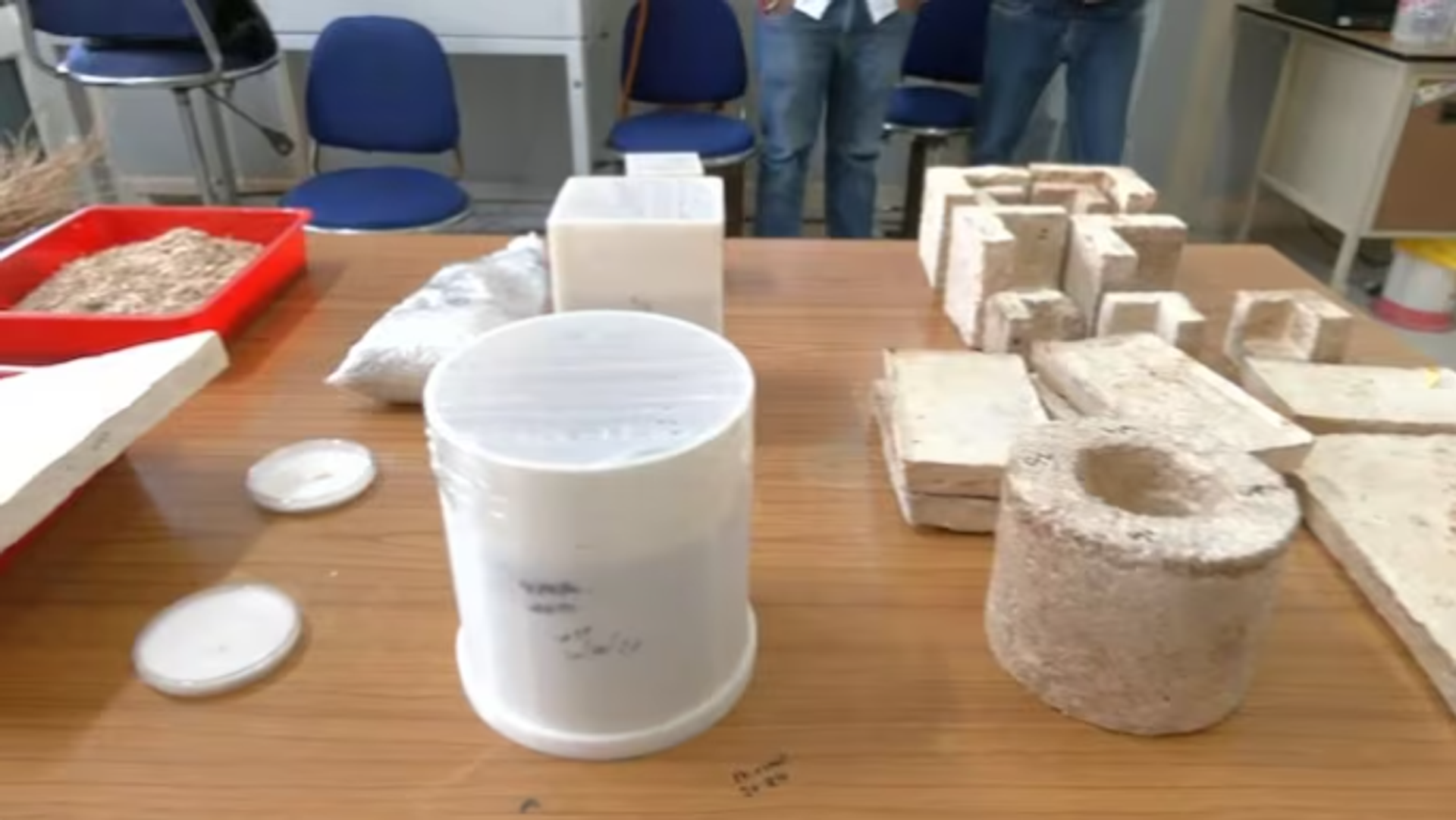https://sputniknews.in/20231102/indian-scientists-develop-bio-thermocol-using-crop-waste-5201772.html
Indian Scientists Develop Bio-Thermocol Using Crop Waste
Indian Scientists Develop Bio-Thermocol Using Crop Waste
Sputnik India
To ease off the issue of pollution due to stubble burning in Punjab and Haryana, Indian scientists have developed 'bio-thermocol' using paddy and wheat stubble.
2023-11-02T19:16+0530
2023-11-02T19:16+0530
2023-11-02T19:17+0530
science & tech
india
indian farmers
punjab
haryana
science & tech
wheat export
wheat export ban
science diplomacy
ministry of earth sciences
https://cdn1.img.sputniknews.in/img/07e7/0b/02/5205634_0:2:682:386_1920x0_80_0_0_43586411dc0cdb2b0a2cc2df7ea4332a.png
Indian scientists have developed a groundbreaking solution to the problem of stubble burning by inventing 'bio-thermocol,' an environmentally friendly alternative that can effectively replace traditional roof ceilings.Dr. Ramesh Chand Kasana, the principal scientist at the Central Institute of Post Harvest Engineering and Technology (CIPHET) of the Indian Council of Agriculture Research (ICAR) told Indian media that 'bio-thermocol' can also be used for "insulation and plastering of the concrete pillars".While the experiment is at an initial stage, the scientists are also brainstorming on various other usages of the paddy stubble.Making of Bio-ThermocolThe 20-day process involves chopping paddy and wheat stubble into small pieces measuring up to a centimeter and sterilizing them in the laboratory.The processed stubble was then joined using an adhesive made of a substrate called spawn which produces mycelium.The mycelium also gives white color to the stubble paste which is molded into various shapes and sizes.Selling Stubble Can Boost Farmers' IncomeThe scientists opined that by selling stubble to the factories, the farmers can boost their income.Dr. Renu Bala of CIPHET told Indian media that they have already signed a MoU with a local industrial unit, making it possible for the farmers to sell the paddy and wheat stubble which they would usually burn.Production of stubbleEvery year, Punjab produces 22 million tons of stubble out of which an estimated 10 million tons are burnt by farmers, causing damage to the environment.The Punjab government claimed that the number of farm fire cases in Punjab has been brought down by 55 per cent. While 34 per cent of the stubble is being used as fodder, 43 per cent is being managed using in situ methods.The Haryana government, on the other hand, claimed that at least two dozen industrial units in the state were using stubble as a fuel, despite some farmers continuing to burn the paddy stubble.
https://sputniknews.in/20231029/humans-could-reproduce-in-space-after-scientists-grow-mouse-embryos-study-5125550.html
india
punjab
haryana
Sputnik India
feedback.hindi@sputniknews.com
+74956456601
MIA „Rossiya Segodnya“
2023
Sangeeta Yadav
https://cdn1.img.sputniknews.in/img/07e6/0c/0f/110602_0:0:641:640_100x100_80_0_0_c298016a79eb02ef8caa9d1f688c12a5.jpg
Sangeeta Yadav
https://cdn1.img.sputniknews.in/img/07e6/0c/0f/110602_0:0:641:640_100x100_80_0_0_c298016a79eb02ef8caa9d1f688c12a5.jpg
News
en_IN
Sputnik India
feedback.hindi@sputniknews.com
+74956456601
MIA „Rossiya Segodnya“
Sputnik India
feedback.hindi@sputniknews.com
+74956456601
MIA „Rossiya Segodnya“
Sangeeta Yadav
https://cdn1.img.sputniknews.in/img/07e6/0c/0f/110602_0:0:641:640_100x100_80_0_0_c298016a79eb02ef8caa9d1f688c12a5.jpg
indian scientists, stubble burning, bio-thermocol, roof ceilings, dr ramesh chand kasana, principal scientist, central institute of post harvest engineering and technology (ciphet), indian council of agriculture research (icar), insulation, plastering of the concrete pillars, industrial thermocol, biodegradable, packaging, laboratory, mycelium, stubble, boost farmers' income, dr renu bala ciphet, industrial unit, paddy, wheat stubble, production, punjab government, haryana government,
indian scientists, stubble burning, bio-thermocol, roof ceilings, dr ramesh chand kasana, principal scientist, central institute of post harvest engineering and technology (ciphet), indian council of agriculture research (icar), insulation, plastering of the concrete pillars, industrial thermocol, biodegradable, packaging, laboratory, mycelium, stubble, boost farmers' income, dr renu bala ciphet, industrial unit, paddy, wheat stubble, production, punjab government, haryana government,
Indian Scientists Develop Bio-Thermocol Using Crop Waste
19:16 02.11.2023 (Updated: 19:17 02.11.2023) To ease off the issue of pollution due to stubble burning in Punjab and Haryana, Indian scientists have developed 'bio-thermocol' using paddy and wheat stubble.
Indian scientists have developed a groundbreaking solution to the problem of stubble burning by inventing 'bio-thermocol,' an environmentally friendly alternative that can effectively replace traditional roof ceilings.
Dr. Ramesh Chand Kasana, the principal scientist at the Central Institute of Post Harvest Engineering and Technology (CIPHET) of the Indian Council of Agriculture Research (ICAR) told Indian media that 'bio-thermocol' can also be used for "insulation and plastering of the concrete pillars".
"Unlike the industrial thermocol, this bio-thermocol is biodegradable and does not cause any harm to nature. It is as light as a thermocouple and can be used for packaging," Kasana said.
While the experiment is at an initial stage, the scientists are also brainstorming on various other usages of the
paddy stubble.
The 20-day process involves chopping paddy and wheat stubble into small pieces measuring up to a centimeter and sterilizing them in the laboratory.
The processed stubble was then joined using an adhesive made of a substrate called spawn which produces mycelium.
The mycelium also gives white color to the stubble paste which is molded into various shapes and sizes.
Selling Stubble Can Boost Farmers' Income
The scientists opined that by
selling stubble to the factories, the farmers can boost their income.
Dr. Renu Bala of CIPHET told Indian media that they have already signed a MoU with a local industrial unit, making it possible for the farmers to sell the paddy and wheat stubble which they would usually burn.
Every year, Punjab produces 22 million tons of stubble out of which an estimated 10 million tons are burnt by farmers, causing damage to the environment.
The Punjab government claimed that the number of farm fire cases in Punjab has been brought down by 55 per cent. While 34 per cent of the stubble is being used as fodder, 43 per cent is being managed using in situ methods.
The Haryana government, on the other hand, claimed that at least two dozen industrial units in the state were using stubble as a fuel, despite some farmers continuing to burn the paddy stubble.



